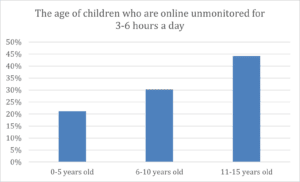Parents Want Network Safeguards For Their Kids Online
Remember the term ‘screen time’? You’d be forgiven for letting that definition slip through your fingers. Screen time has appeared to lose meaning as there are multiple screens (and apps) and multiple opportunities to be connected. The simple fact is that online time is increasing, and parents and guardians simply can’t regulate or supervise all the activity. We anticipate that the next generation is growing up with this tech and will become more aware of the pitfalls – but unfettered internet access for a younger generation is something that is viewed very much with the potential for harm in mind.
In order to put some scale on this Enea commissioned Censuswide to interview more than 4,000 parents in the US, UK, France, Germany, Italy and Spain to assess their children’s online activity.

Unsupervised mobile activity was a headache for parents of children of all ages.
44% of those aged 11-15 and 30% of those aged 6-10 spent between 3 and 6 hours browsing the internet unsupervised every day during lockdown. Even parents of those aged 5 and under reported their youngsters spending at least an hour a day unsupervised on a mobile device.
These issues seemed most prevalent in the US, where the proportion of children across all age groups spending 3-6 hours per day online unmonitored was at its highest at 41%.
The UK was close behind at 33%, with France, Germany, Italy, and Spain all hovering around the 30% mark. So, the focus naturally turns toward technology such as parental controls, firewalls and other automated solutions that can keep children safe as they browse the internet. But who should provide these tools, how good are they, and how to parents feel about them?
The Response To The Survey
taking a look at this handy info graphic from the survey response we can summarise; more than 80% said they’d absolutely welcome additional parental controls and safeguards, but there were some differing opinions when it came to sourcing these tools. Less than a quarter of all those asked said they’d trust Google, Facebook, or any other social media provider with their child’s online safety. An interesting side note was that mothers seemed to be less trusting than fathers of any third party when it came to protecting their children from harmful online content.
So where do parents & guardians turn?
While the survey revealed an element of distrust toward third parties like Google and Facebook, nearly 6 in 10 (58%) parents said they’d be more than happy to pay $5 to $14 more per month to provide more effective safeguard controls for screen time. Even more surprising, was that more than half (56%) of those asked said they would be willing to leave their current mobile network provider for one that offered better parental controls at the same price.
Who do parents trust to safeguard children online?
In the same survey, we asked each parent who they’d most trust with the safeguarding of their children’s online activity. More than 80% said they would welcome additional parental controls and safeguards, but there were some differing opinions when it came to sourcing these tools.
Less than a quarter of all those asked said they’d trust Google, Facebook or any other social media provider with their child’s online safety. An interesting side note was that mothers seemed to be less trusting than fathers of any third party when it came to protecting their children from harmful online content. So where do parents turn?
The role mobile network operators play in protecting children online
While there are many device-based parental control products available, most children are tech-savvy and can find ways to circumvent the safeguards on laptops and phone apps. However, the parental control solutions that are network-based are harder to by-pass and provide parents with robust safeguarding mechanisms. As such, mobile operators can play a pivotal role to protect vulnerable users on their network.
It is of course not as simple as it sounds as over 96% of mobile traffic is encrypted with strong safeguards preventing decryption. Therefore, the challenge for mobile operator is to deploy AI-based traffic classification systems that can instantly identify content based on statistical prediction, behavioural analysis and heuristics. This will help operators to deliver parental control solutions that are effective – now and well into the future.
Enea has such solutions, to be deployed, in network and with consent of the bill payer / account owner which can enable a safer on-line experience.
Download the full exclusive report on mobile operator parental controls
Check out of traffic classification and parental control options @ https://www.enea.com/solutions/traffic-management/content-filtering/




